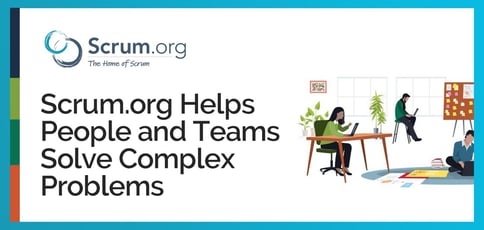
TL; DR: Scrum.org is a training and certification body that uses the principles of Scrum to help people and teams with complicated product delivery. In addition to software development and site-building teams, groups from a broad range of industries now leverage the framework to improve their problem-solving abilities. Scrum.org’s ultimate goal is to ensure consistent and competent Scrum understanding across the globe via continuous learning paths that foster collaboration and operational agility.
As the popularity of online education continues to soar, so have opportunities to earn professional software certifications in nearly every flavor imaginable.
But loading up on easy-to-earn certifications isn’t necessarily the best move. Hiring managers of website-building and development teams know that the training courses required to earn them are not equally rigorous. And quality always beats quantity.
“I’ve seen organizations that consider 60% a passing score for a certification,” said Eric Naiburg, Chief Operating Officer at Scrum.org. “If one of my kids got a 60% on an exam at school, I’d get an email from the teacher. Yet professionals earn certifications for the same level of competency in their respective subject area and we believe certification should be proven and earned, requiring an 85% score.”

Scrum.org was founded to improve the state of Scrum training and education.
Scrum is a framework for effective collaboration on complex projects that helps people and teams solve problems more efficiently. Based on these principles, Scrum.org provides consistent content, training, assessments, and certifications.
Unlike other programs, however, Scrum.org has decoupled certification assessments and training. To receive Professional Scrum certification, learners can’t just sit through a class. They must demonstrate their knowledge, understanding, and ability to apply Scrum in a real-world setting and pass an assessment test with a score of 85% or better.
“We built an organization where you can get certified, and you can get trained. If you get trained, you get a free attempt at certification, but certification shouldn’t be automatic upon taking a training class. We need to test and validate that knowledge.”
Today, Scrum.org has more than 340 Professional Scrum Trainers (PSTs) who bring current agile practices and years of Scrum experience to the classrooms across the globe. As a result, Professional Scrum certifications are seen as proof that a professional possesses the highest level of Scrum knowledge.
A Popular Development Model Captured in “The Scrum Guide”
Scrum co-creators Ken Schwaber and Jeff Sutherland developed the Scrum framework. They introduced it to the world for the first time at OOPSLA (Conference on Object-Oriented Programming Systems, Languages, and Applications) in 1995.
Ken later founded Scrum.org in 2009 to help people and teams meet the demands of increasingly complex technologies and products.
The organization bases its learning objectives on the 2017 version of the “The Scrum Guide,” a free resource created by Ken Schwaber and Jeff Sutherland to clearly define the framework’s roles, events, and rules. (The first edition of “The Scrum Guide” was published in 2010).

Scrum.org provides a wealth of free resources in addition to paid certification opportunities.
“Scrum.org was founded on the idea to help people and teams solve complex problems through training, certification, and ongoing continuous thought leadership,” Eric said. “Ken has always wanted to make sure to remove any barriers to access in terms of content, so we provide a ton of free materials.”
Site visitors don’t have to create a profile, log in, or submit any forms to benefit from the content on Scrum.org. Eric said the organization will continue to put out free content to help people benefit from the framework.
“We’re not just here building certifications — we’re mission-based, and our mission is to help people,” he said. “If they want to get certified, that’s great; if they don’t, that’s okay, too. Making Scrum available to all will allow everyone to generate value.”
Ensuring Consistent Training Across the Globe
Eric told us that Scrum has evolved from a model used in software development, site-building, and other technology-related efforts to one with more of a universal application.
“We see Scrum being used in operations, human resources, and marketing,” he said. “It’s being used to build complex systems like automobiles. We’ve even seen cases where parents use it to provide structure for children with ADHD.”
From a training perspective, Eric said Scrum.org has seen a growing need to educate not just individuals but entire organizations looking to transform and evolve.
“A lot of training organizations in our industry and others will license companies to provide training on their behalf.”
Scrum.org is different. The organization’s Professional Scrum Trainers (PSTs) must each pass a series of peer reviews, tests, training, and interviews before becoming certified and licensed as a PST. In addition to teaching, they must continuously spend time on Scrum Teams to bring real-world experience to their instructions.
“All of our trainers go through extensive training and validation of their knowledge before they’re able to teach our material,” he said. “We don’t license any company to teach our material — only individuals — because we want to make sure that they’re not coming in and just showing people some slides, but they’re teaching based on a consistent, firm understanding of Scrum, as well as real-world experience.”
A Consistent Approach Focused on Transparency
Another factor in training that is important to Ken — and part of the reason he founded Scrum.org — is consistency. PSTs worldwide all use the same content and materials so that teams around the world receive the same messages.
“Many companies will bring us into their global organizations and want to be able to leverage trainers all over the world,” Eric told us. “They don’t want to worry about their people receiving different experiences.”
Each Scrum.org course is assigned two stewards who are responsible for collecting input on course materials.
“Those stewards are responsible for capturing information from our 340-plus trainers around the world as feedback to improve the courses,” Eric said. “They rotate in and out every two to three years, collecting feedback from the greater community that leads to a high-quality student experience and an environment of consistent learning around the world.”
PSTs store each course in GitHub, providing transparent version control, feedback mechanisms, and distribution. The process is similar to the one developers and site-building teams create while using the Scrum framework themselves.
“It’s constant feedback, and it is transparent. With GitHub, people really understand where their feedback is coming and going,” Eric said.
Building Bridges and Continuous Learning Paths
As Scrum.org moves forward, the organization will focus on two objectives: providing continuous learning opportunities and broadening industry reach.
“We’re spending a lot of time building out learning paths for the various Scrum roles, including Professional Scrum Masters, Professional Scrum Product Owners, and Professional Scrum Developers,” Eric said. “It’s about building out and investing in those learning paths through free content on the site. Real professionals are constantly learning and improving.”
Scrum.org will focus on building bridges between Scrum and other frameworks, such as Kanban, which is centered on agile and DevOps software development.
“With the Professional Scrum with Kanban (PSK), for example, we’re bringing in practices from Kanban to improve your flow and transparency, making your Scrum teams more effective,” Eric said. “For the PSK course we worked with Kanban experts Daniel Vacanti and Yuval Yeret to design and build that course. We worked with Jeff Gothelf and Josh Seiden, who wrote ‘Lean UX,’ to build our Professional ScrumTM with User Experience (PSU) course as yet another example of bridge-building.”
Eric said Scrum.org will continue to build bridges across communities in that manner. The organization is also working to support the Scrum framework in conjunction with fields like marketing and human resources.
“The 2020 version of ‘The Scrum Guide’ was released recently, and it’s made the framework more agnostic,” he said.
HostingAdvice.com is a free online resource that offers valuable content and comparison services to users. To keep this resource 100% free, we receive compensation from many of the offers listed on the site. Along with key review factors, this compensation may impact how and where products appear across the site (including, for example, the order in which they appear). HostingAdvice.com does not include the entire universe of available offers. Editorial opinions expressed on the site are strictly our own and are not provided, endorsed, or approved by advertisers.
Our site is committed to publishing independent, accurate content guided by strict editorial guidelines. Before articles and reviews are published on our site, they undergo a thorough review process performed by a team of independent editors and subject-matter experts to ensure the content’s accuracy, timeliness, and impartiality. Our editorial team is separate and independent of our site’s advertisers, and the opinions they express on our site are their own. To read more about our team members and their editorial backgrounds, please visit our site’s About page.

